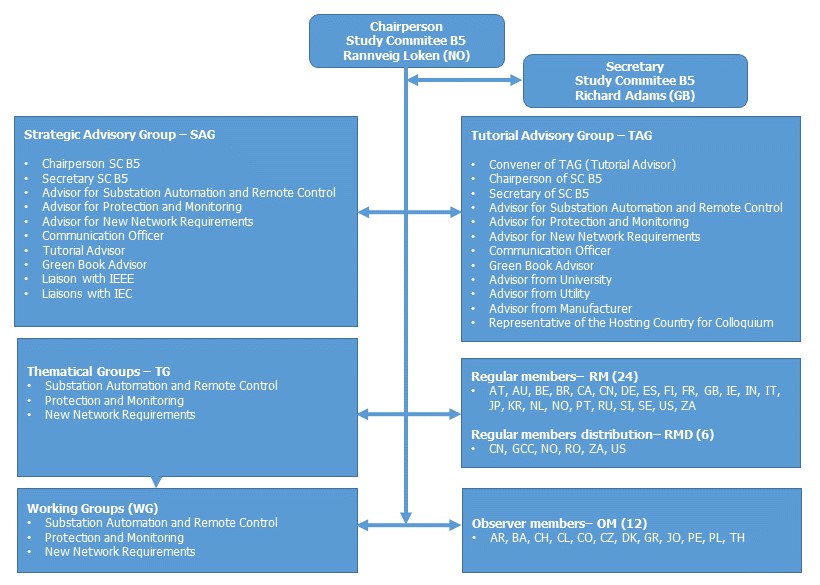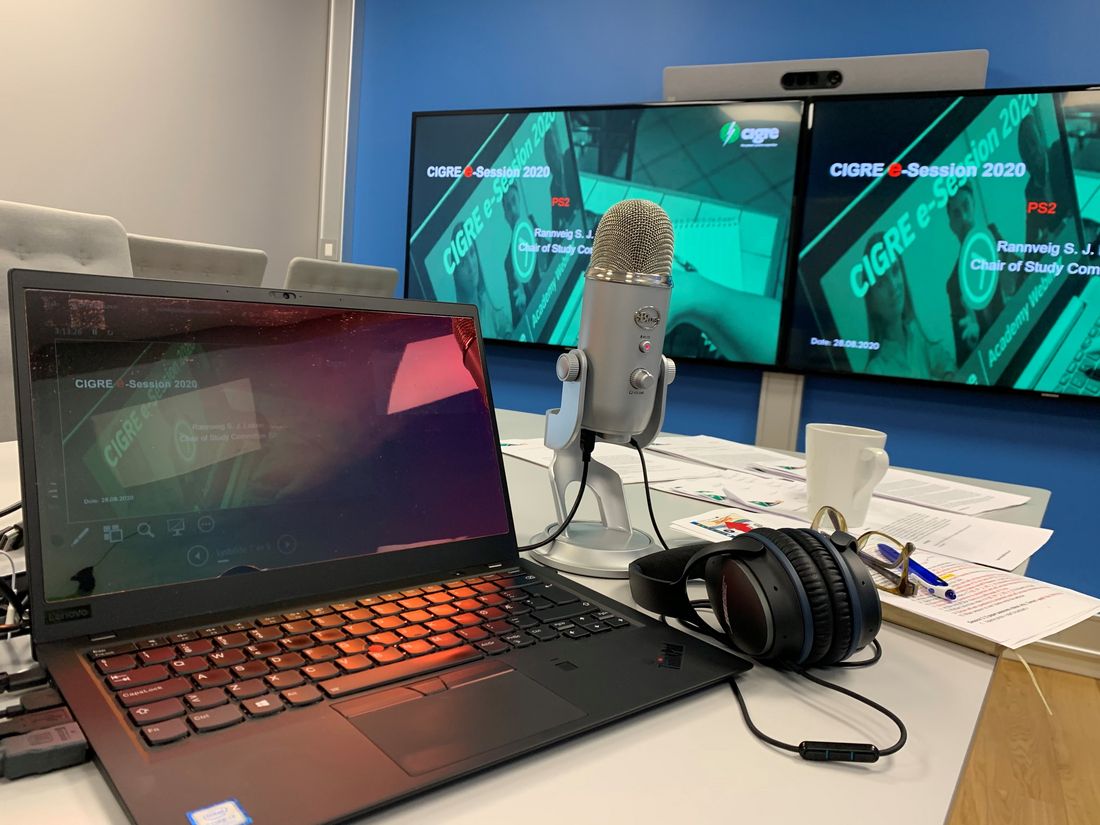Protection and Automation
By Rannveig S. Løken, Chair & Richard Adams, Secretary
Introduction
This report reviews the organization, processes, results and activities of Study Committee B5 (SC B5) in the year 2020. CIGRE Study Committee B5 - Protection and Automation, or SC B5 for short, focuses on Protection, Control, Monitoring and Metering and aims to cover the whole Power system, end-to-end related to this topic, from transmission systems, to distribution systems, including generation and HVDC systems.
Objectives
Study Committee B5 promotes the synthesis and dissemination of state of the art practices, recommendations and information about Power System Protection and Automation on a worldwide basis. Its main activities cover the principles, design, application and management of power system protection, substation control, automation, monitoring, recording and metering, as well as the associated internal and external communications and interfacing for remote control and monitoring. SC B5 aims to be an independent analyzer of different solutions and provider of high quality unbiased publications and contributions to the electrical supply industry. Members of SC B5 from all regions of the world provide a global perspective on the issues and challenges facing the protection of electrical power systems, aimed at top and medium management and technical staff of utilities, suppliers and consultants, universities and research centers, including young and experienced engineers and standardization organizations.
Organization
To attain its objectives, SC B5 is organized as shown on Picture 1. Five advisory groups support the decisions of the chair and secretary: the Strategic Advisory Group (SAG), the Tutorial Advisory Group (TAG), and three Strategic Thematic Groups (TG) specialized in Substation and Automation, Protection and Monitoring, and New Network Requirements, respectively. The Study Committee is formed by twenty-four regular country members, six additional regular members from distribution, twelve observer members, several Working Groups (WG) and Joint Working Groups with other Study Committees and organizations.

Picture 1 – SC B5 Organization
It is the mission of the Strategic Advisory Group (SAG) to advise the chair about strategic issues related to the activities of the committee, helping in the elaboration of the SC Strategic Plan. The Tutorial Advisory Group (TAG) advises about the organization and promotion of tutorial activities of the committee, selecting the topics for the tutorials, the presentation material, appointment of lecturers and monitoring their quality. The three permanent Strategic Thematic Groups (TG) organize the proposals of new Working Groups and Preferential Subjects related to Substation Automation, Protection and Monitoring, and New Network Requirements for discussion and voting during SC B5 meetings and select reviewers of the final reports of the Working Groups.
Table 1, 2 and 3 shows the WGs that were active at the end of 2020, organized by Strategic Thematic Groups (TG), with their respective conveners.
Table 1 - TG 51 - Substation Automation and Remote Control
B5.56 | Optimization of Protection Automation and Control Systems, P. Kreutzer (CH) |
|---|---|
B5.59 | Requirements for Near-Process Intelligent Electronic Devices, X. Lei (CN) |
B5.60 | Protection, Automation and Control Architectures with Functionality Independent of Hardware, A. Voloshin (RU) |
B5.63 | Protection, Automation and Control System Asset Management, M. Petrini (IT) |
B5.68 | Optimisation of the IEC 61850 Protection, Automation and Control Systems (PACS) engineering process and tools, C. Bloch (FR) |
B5.69 | Experience gained and Recommendations for Implementation of Process Bus in Protection, Automation and Control Systems (PACS), A. Apostolov (US) |
B5.71 | Protection, Automation and Control Systems Communication Requirements for Inter-Substation and Wide Area Applications, C. Moors (BE) |
B5.73 | Experiences and Trends related to Protection Automation and Control Systems Functional Integration, A. Bruno (FR) |
Table 2 - TG 52 - Protection and Monitoring
B5.48 | Protection for developing network with limited fault current capability of generation, T. Bi (CN) |
|---|---|
B5.52 | Analysis and comparison of fault location systems in AC power networks, A. Montenegro (SE) |
B5.55 | Application of Travelling Wave Technology for Protection and Automation, P. Crossley (GB) |
B5.57 | New challenges for frequency protection, V. Terzija (GB) |
B5.58 | Faster protection and network automation systems: implications and requirements, A. Podshivalin (RU) |
B5.65 | Enhancing Protection System Performance by Optimising the Response of Inverter-Based Sources, F. Filho (BR) |
B5.74 | Busbar Protection Considerations When Using IEC 61850 Process Bus, P. Flores (BR) |
C4/B5.41 | Challenges with series compensation application in power systems when overcompensating lines, L. Haarla (FI) |
Table 3 - TG 53 - New Network Requirements
B5.62 | Life Cycle Testing of Synchrophasor Based Systems used for Protection, Monitoring and Control, M. Kezunovic (US) |
|---|---|
B5.64 | Methods for Specification of Functional Requirements of Protection, Automation, and Control, I. Patriota (BR) |
B5.70 | Reliability of Protection Automation and Control System (PACS) of power systems – Evaluation Methods and Comparison of Architectures, A. Voloshin (RU) |
B5.72 | Modelling, Assessment, and Mitigation of Protection Performance Issues caused by power plants during Dynamic Grid Events, S. McGuinness (IE) |
B5/C4.61 | Impact of Low Inertia Network on Protection and Control, R. Zhang (GB) |
B5/D2.67 | Time synchronization for protection devices, J. Yubo (CN) |

CIGRE active Working Groups / Call for experts
Technical activities
In 2020, three new WGs were suggested during the SC B5 eSession in "Paris, France", and was approved by the Technical Council Chair in 2020/2021, to address current issues related to protection and automation of power systems:
- WG B5.74 - Busbar Protection Considerations When Using IEC 61850 Process Bus, Convenor P. Flores (BR)
- WG B5.75 - Documentation and version handling related to Protection, Automation and Control functions, Convenor S. Khot (CA)
- WG B5.76 - Architecture, Standards and Specification for metering system in a Digital Substation and Protection, Automation and Control (PACS) Environment, Convenor A. Roumpies (CH)
Five WG's were disbanded by the chair in 2020 with the Technical Brochure sent for publication:
- The Technical Brochure 789 – SC B5, WG B5.41 "Improved Metering Systems for Billing Purposes in Substations". The Convener of this Working Group was Richard Adams from United Kingdom. Metering has always been a part of SC B5 scope, but it is usually kept separate from protection and control systems, largely due to the sensitive financial aspect of the data/transactions and different personnel and departments involved. The scope of the Working Group was to cover metering in substations and to that end the Brochure covers medium voltage and above. The subject of smart metering and residential/small industry metering is not within the scope of this document.
- The Technical Brochure 800 – SC B5, WG B5.47 "Network Protection Performance Audit". The Convener of this Working Group was Peter Watson from United Kingdom. Considering the rapid changes to which transmission and distribution networks are subjected, and the ever-shorter expected useful life of numeric protection relays, the requirement for network protection performance audits as part of the lifetime management of protection systems is becoming a necessity. The capability and availability of steady state single frequency phasor-based power system and protection analysis software packages now make it possible to undertake “wide-area” protection performance audits. The scope of the Working Group was to cover the possibilities, advantages and requirements for utilising proprietary power system and protection analysis software for undertaking protection performance audits of transmission and distribution systems involving hundreds or thousands of protection devices.
- The Technical Brochure 819 – SC B5, WG B5.50 "IEC 61850 Based Substation Automation Systems – Users Expectations and Stakeholders Interaction". The Convener of this Working Group was Patrik Lindblad from Finland. The IEC 61850 standard series has gradually replaced old protocols in Digital Substation Automation Systems. Its main user benefit is to allow interoperability between Intelligent Electronic Devices of different vendors in automation systems and increase DSAS engineering efficiency. However, early implementation experiences pointed out several difficulties in applying the standard. This Brochure covers both general and detailed level user expectations for IEC 61850 based DSAS and describes main stakeholder interactions that are needed in order to improve the interoperability.
- The Technical Brochure 810 – SC B5, WG B5.54 "Protection and Automation Issues of Islanded Systems During System Restoration/Black Start". The Convener of this Working Group was Nirmal Nair from New Zealand. Large scale global blackouts of the last two decades highlight certain Protection and Automation responses, which falls directly under the scope of SC B5, having potentially contributed towards delayed restoration and in some cases led to abandonment of intended restoration procedures in favour of slow but sure procedures. There was a need towards investigating Protection and Automation issues during system restoration with focus on network re-energization and resynchronization. This required revisiting CIGRE Technical Brochures that investigated and documented the restoration procedures used both in transmission and distribution networks. This Technical Brochure has integrated three strands of contributions based on the existing body of technical knowledge, Working Group member experiences and curation of technical contributions arising from a survey conducted by this Working Group and 2018 SC B5 Preferential Subject Special Report contributions relevant to this area.
- The Technical Brochure 790 – SC B5, WG B5.66 "Cybersecurity Requirements for PACS and The Resilience of PAC Architectures". The Convener of this Working Group was Dennis Holstein from USA. This Technical Brochure offers an insight into the emerging threat landscape with attention paid to common protection, automation and control systems (PACS). Overlaid on this portrait is the imposition of emerging laws and regulations. From this assessment it was clear that a dramatic sea change will be required to modernize existing EPU policies, procedures, and organizational directives. A well-defined model-based system engineering (MBSE) process was used to define selected views of PACS-centric systems of interest. Using MBSE each impact is associated with recommended solutions to improve the security posture of PACS operations. For example, the capabilities needed to implement an integrated security operation center clearly shows that special personnel skills and advanced analytical tools are badly needed to improve the maturity PACS security posture and to implement a proactive or anticipatory security strategy.

The best paper from SC B5 during the e-session 2020 was:
- "Human errors related to PACs: experience and expectations of Elia, the Belgian TSO" - C. MOORS et al.
It will be published in CIGRE Science & Engineering (CSE) in 2021.
Tutorials
To promote the discussion of current issues related to protection and automation, and as part of its mission to help the dissemination of knowledge about protection and automation, in 2020 the following tutorials were presented by SC B5 members.
SC B5 Tutorial during e-session August 2020 with the following topics:
- Tutorial Introduction by TAG Advisor Klaus-Peter Brand (CH)
- Distribution Protection by Gernot Druml (AT)
- Improved metering systems for billing purposes in substations by Alex Roumpies (CH)
Keynote speeches
To disseminate the activities of CIGRE, members from SC B5 have participated and presented Keynote speeches during:
- IEEE PES PSRCC Satellite Committee China Wuhan, October 2020
- CIGRE B5 Smart Grid Transformation, New Zealand, October 2020
- EPRI conference 4th Relay Protection Technology Forum, China, October 2020
- CIGRE New Zealand workshop, November 2020
E-session and SC B5 discussion sessions
The main forum for technical debates about Protection and Automation in 2020 was the virtual eSession event in "Paris, France". SC B5 presented the papers in two sessions during this event and the papers submitted addressed topics related to the following Preferential Subjects:
-
PS1 – Human aspects in Protection, Automation and Control (PACS)
Topics selected for discussion include Causes, types, stages of occurrence and consequences of human errors, Impact of PACS complexity and degree of functional integration on human errors, Prevention of human errors including training, work authorization and peer reviews, procedures, application templates and standardization, and best practices for working with subcontractors and third parties. The session was reported by Simon Hussey (IE).

Alone and together during e-session in "Paris, France"
-
PS2 – Communication network in Protection, Automation and control (PACS): Experience and challenges
Topics selected for discussion include Management of Redundancy in communication network for applications and Intelligent Electronic Device (IED), Data Segregation including use of virtual networks for PACS applications, Architecture of PACS communication network including Management of communication constraints. The session was reported by John Wright (UK).
For 2021, SC B5 will take part in the Hybrid Session in Paris, France, and papers submitted on the following Preferential Subjects will be discussed based on the questions from the special report from SC B5:
-
PS1 – Human aspects in Protection, Automation and Control (PACS)
Topics selected for discussion include: Causes, types, stages of occurrence and consequences of human errors, Impact of PACS complexity and degree of functional integration on human errors, Prevention of human errors including training, work authorization and peer reviews, procedures, application templates and standardization, and best practices for working with subcontractors and third parties. The session will be reported by Simon Hussey (IE).
-
PS2 – Communication network in Protection, Automation and control (PACS): Experience and challenges
Topics selected for discussion include Management of Redundancy in communication network for applications and Intelligent Electronic Device (IED), Data Segregation including use of virtual networks for PACS applications, Architecture of PACS communication network including Management of communication constraints. The session will be reported by John Wright (UK).
Awards
In recognition for their contribution to the activities of CIGRE, SC B5 has nominated the following recipients for awards in 2020:
CIGRE SC B5 Outstanding Service Award
The Outstanding Service Award of CIGRE Study Committee B5 - Protection and Automation is granted by the SC Chairman annually to members in recognition for outstanding participation and contribution to the activities of the Study Committee. For 2020, the award went to Richard Adams, from UK in recognition of his contribution, commitment and dedication to the objectives of CIGRE. He is a recognized expert in power system automation, he is the Secretary of SC B5, and has also been frequent contributor to CIGRE Working Groups, as WG conveners. The award ceremony was conducted digitally by the Chair of SC B5 during the SC B5 eMeeting.
CIGRE Technical Council Award
Technical Council Award recipient from SC B5 in 2020 was Mr Massimo Petrini from Italy. His main working area being use of IEC 61850 in protection, automation and control systems, and asset management of protection, automation and control systems. Massimo Petrini has been and remains an active member of the CIGRE B5 community; he has published several papers and attended the B5 colloquia and Paris sessions over the years. He shares his knowledge and participates in discussions related to the CIGRE B5 activities. He is the convenor of Working Group B5.63 “Protection, Automation and Control System Asset Management”. Massimo has previously been the convenor of B5.42 “Experience concerning availability and reliability of DSAS” He has also been a regular and active member in several other WGs within SC B5. Mr Massimo Petrini has shared his knowledge with the CIGRE B5 community for many years and his contributions are very valuable to CIGRE B5. The award ceremony was conducted digitally during the opening of the eSession 2020.
Strategic planning
The strategic plan of CIGRE Study Committee B5 – sets out the strategic technical directions to be followed by the B5 Committee over the period 2020–2029 in order to address the main objectives set by CIGRE Technical Committee.
Based on this analysis, the following technical directions were validated by SC B5 Strategic Plan for the period 2020-2029:
Influence and Contribute towards Protection and Automation Global Expertise
- Providing Key Technical SC B5 PACS information to Executives, Regulators, Policy Makers and Technology Innovators
- Increase brand and visibility of SC B5 PACS amongst membership, research academics, trade associations, regulators, policy makers and government.
- Developing Marketing avenues and platforms to support leading edge innovative concepts of B5
- CIGRE B5 Africa Strategy
Supporting CIGRE Power System of the Future Vision: SC B5 Strategy
-
Understand and influence the development of new technology and practices for all voltages and systems
Supporting CIGRE Peoples and Skill of Future Strategy: SC B5 Efforts
-
Engaging actively with Central Office efforts towards operation Excellence
Details about the process adopted by SC B5 and the complete result can be found in the Strategic Plan.
Conclusions
The year of 2020 was full of achievements for SC B5, a result of the voluntary work of dedicated individuals and organizations, including the secretary, advisors, conveners, special reporters, members and observers from many countries around the world. For the future, the strategic directions set by SC B5 aim to facilitate the human development and application of new technology to improve the efficiency of the engineering, design, operation and maintenance of protection and automation of electric power systems and keeping the spirit of collaboration that distinguishes CIGRE among organizations around the world.

